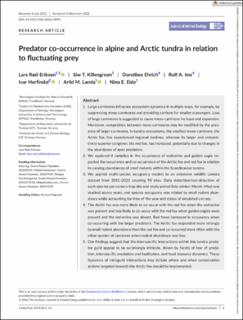| dc.contributor.author | Rød-Eriksen, Lars | |
| dc.contributor.author | Killengreen, Siw Turid | |
| dc.contributor.author | Ehrich, Dorothee | |
| dc.contributor.author | Ims, Rolf Anker | |
| dc.contributor.author | Herfindal, Ivar | |
| dc.contributor.author | Landa, Arild | |
| dc.contributor.author | Eide, Nina Elisabeth | |
| dc.date.accessioned | 2023-01-31T15:31:31Z | |
| dc.date.available | 2023-01-31T15:31:31Z | |
| dc.date.created | 2023-01-26T13:03:21Z | |
| dc.date.issued | 2022 | |
| dc.identifier.citation | Journal of Animal Ecology. 2022, . | en_US |
| dc.identifier.issn | 0021-8790 | |
| dc.identifier.uri | https://hdl.handle.net/11250/3047495 | |
| dc.description.abstract | 1. Large carnivores influence ecosystem dynamics in multiple ways, for example, by suppressing meso-carnivores and providing carrions for smaller scavengers. Loss of large carnivores is suggested to cause meso-carnivore increase and expansion. Moreover, competition between meso-carnivores may be modified by the presence of larger carnivores. In tundra ecosystems, the smallest meso-carnivore, the Arctic fox, has experienced regional declines, whereas its larger and competitively superior congener, the red fox, has increased, potentially due to changes in the abundance of apex predators.
2. We explored if variation in the occurrence of wolverine and golden eagle impacted the occurrence and co-occurrence of the Arctic fox and red fox in relation to varying abundances of small rodents within the Scandinavian tundra.
3. We applied multi-species occupancy models to an extensive wildlife camera dataset from 2011–2020 covering 98 sites. Daily detection/non-detection of each species per camera trap site and study period (late winter; March–May) was stacked across years, and species occupancy was related to small rodent abundance while accounting for time of the year and status of simulated carcass.
4. The Arctic fox was more likely to co-occur with the red fox when the wolverine was present and less likely to co-occur with the red fox when golden eagles were present and the wolverine was absent. Red foxes increased in occupancy when co-occurring with the larger predators. The Arctic fox responded more strongly to small rodent abundance than the red fox and co-occurred more often with the other species at carcasses when rodent abundance was low.
5. Our findings suggest that the interspecific interactions within this tundra predator guild appear to be surprisingly intricate, driven by facets of fear of predation, interspecific mediation and facilitation, and food resource dynamics. These dynamics of intraguild interactions may dictate where and when conservation actions targeted towards the Arctic fox should be implemented. | en_US |
| dc.language.iso | eng | en_US |
| dc.publisher | British Ecological Society | en_US |
| dc.rights | Navngivelse 4.0 Internasjonal | * |
| dc.rights.uri | http://creativecommons.org/licenses/by/4.0/deed.no | * |
| dc.title | Predator co-occurrence in alpine and Arctic tundra in relation to fluctuating prey | en_US |
| dc.title.alternative | Predator co-occurrence in alpine and Arctic tundra in relation to fluctuating prey | en_US |
| dc.type | Peer reviewed | en_US |
| dc.type | Journal article | en_US |
| dc.description.version | publishedVersion | en_US |
| dc.source.pagenumber | 13 | en_US |
| dc.source.journal | Journal of Animal Ecology | en_US |
| dc.identifier.doi | 10.1111/1365-2656.13875 | |
| dc.identifier.cristin | 2115632 | |
| cristin.ispublished | true | |
| cristin.fulltext | original | |
| cristin.qualitycode | 2 | |

